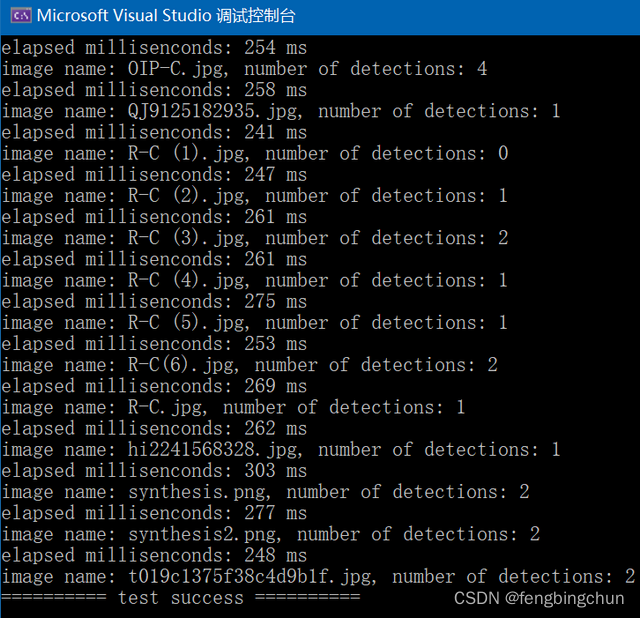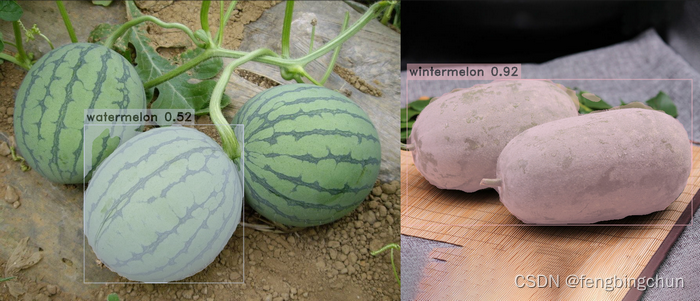在网上下载了60多幅包含西瓜和冬瓜的图像组成melon数据集,使用 EISeg 工具进行标注,然后使用 eiseg2yolov8 脚本将.json文件转换成YOLOv8支持的.txt文件,并自动生成YOLOv8支持的目录结构,包括melon.yaml文件,其内容如下:
path: ../datasets/melon_seg # dataset root dir
train: images/train # train images (relative to 'path')
val: images/val # val images (relative to 'path')
test: # test images (optional)
# Classes
names:
0: watermelon
1: wintermelon对melon数据集进行训练的Python实现如下:最终生成的模型文件有best.pt、best.onnx、best.torchscript
import argparse
import colorama
from ultralytics import YOLO
def parse_args():
parser = argparse.ArgumentParser(description="YOLOv8 train")
parser.add_argument("--yaml", required=True, type=str, help="yaml file")
parser.add_argument("--epochs", required=True, type=int, help="number of training")
parser.add_argument("--task", required=True, type=str, choices=["detect", "segment"], help="specify what kind of task")
args = parser.parse_args()
return args
def train(task, yaml, epochs):
if task == "detect":
model = YOLO("yolov8n.pt") # load a pretrained model
elif task == "segment":
model = YOLO("yolov8n-seg.pt") # load a pretrained model
else:
print(colorama.Fore.RED + "Error: unsupported task:", task)
raise
results = model.train(data=yaml, epochs=epochs, imgsz=640) # train the model
metrics = model.val() # It'll automatically evaluate the data you trained, no arguments needed, dataset and settings remembered
model.export(format="onnx") #, dynamic=True) # export the model, cannot specify dynamic=True, opencv does not support
# model.export(format="onnx", opset=12, simplify=True, dynamic=False, imgsz=640)
model.export(format="torchscript") # libtorch
if __name__ == "__main__":
colorama.init()
args = parse_args()
train(args.task, args.yaml, args.epochs)
print(colorama.Fore.GREEN + "====== execution completed ======")以下是使用libtorch接口加载torchscript文件进行实例分割的实现代码:
namespace {
constexpr bool cuda_enabled{ false };
constexpr int input_size[2]{ 640, 640 }; // {height,width}, input shape (1, 3, 640, 640) BCHW and output shape(s): detect:(1,6,8400); segment:(1,38,8400),(1,32,160,160)
constexpr float confidence_threshold{ 0.45 }; // confidence threshold
constexpr float iou_threshold{ 0.50 }; // iou threshold
constexpr float mask_threshold{ 0.50 }; // segment mask threshold
#ifdef _MSC_VER
constexpr char* onnx_file{ "../../../data/best.onnx" };
constexpr char* torchscript_file{ "../../../data/best.torchscript" };
constexpr char* images_dir{ "../../../data/images/predict" };
constexpr char* result_dir{ "../../../data/result" };
constexpr char* classes_file{ "../../../data/images/labels.txt" };
#else
constexpr char* onnx_file{ "data/best.onnx" };
constexpr char* torchscript_file{ "data/best.torchscript" };
constexpr char* images_dir{ "data/images/predict" };
constexpr char* result_dir{ "data/result" };
constexpr char* classes_file{ "data/images/labels.txt" };
#endif
cv::Mat modify_image_size(const cv::Mat& img)
{
auto max = std::max(img.rows, img.cols);
cv::Mat ret = cv::Mat::zeros(max, max, CV_8UC3);
img.copyTo(ret(cv::Rect(0, 0, img.cols, img.rows)));
return ret;
}
std::vector<std::string> parse_classes_file(const char* name)
{
std::vector<std::string> classes;
std::ifstream file(name);
if (!file.is_open()) {
std::cerr << "Error: fail to open classes file: " << name << std::endl;
return classes;
}
std::string line;
while (std::getline(file, line)) {
auto pos = line.find_first_of(" ");
classes.emplace_back(line.substr(0, pos));
}
file.close();
return classes;
}
auto get_dir_images(const char* name)
{
std::map<std::string, std::string> images; // image name, image path + image name
for (auto const& dir_entry : std::filesystem::directory_iterator(name)) {
if (dir_entry.is_regular_file())
images[dir_entry.path().filename().string()] = dir_entry.path().string();
}
return images;
}
float image_preprocess(const cv::Mat& src, cv::Mat& dst)
{
cv::cvtColor(src, dst, cv::COLOR_BGR2RGB);
float scalex = src.cols * 1.f / input_size[1];
float scaley = src.rows * 1.f / input_size[0];
if (scalex > scaley)
cv::resize(dst, dst, cv::Size(input_size[1], static_cast<int>(src.rows / scalex)));
else
cv::resize(dst, dst, cv::Size(static_cast<int>(src.cols / scaley), input_size[0]));
cv::Mat tmp = cv::Mat::zeros(input_size[0], input_size[1], CV_8UC3);
dst.copyTo(tmp(cv::Rect(0, 0, dst.cols, dst.rows)));
dst = tmp;
return (scalex > scaley) ? scalex : scaley;
}
void get_masks(const cv::Mat& features, const cv::Mat& proto, const std::vector<int>& output1_sizes, const cv::Mat& frame, const cv::Rect box, cv::Mat& mk)
{
const cv::Size shape_src(frame.cols, frame.rows), shape_input(input_size[1], input_size[0]), shape_mask(output1_sizes[3], output1_sizes[2]);
cv::Mat res = (features * proto).t();
res = res.reshape(1, { shape_mask.height, shape_mask.width });
// apply sigmoid to the mask
cv::exp(-res, res);
res = 1.0 / (1.0 + res);
cv::resize(res, res, shape_input);
float scalex = shape_src.width * 1.0 / shape_input.width;
float scaley = shape_src.height * 1.0 / shape_input.height;
cv::Mat tmp;
if (scalex > scaley)
cv::resize(res, tmp, cv::Size(shape_src.width, static_cast<int>(shape_input.height * scalex)));
else
cv::resize(res, tmp, cv::Size(static_cast<int>(shape_input.width * scaley), shape_src.height));
cv::Mat dst = tmp(cv::Rect(0, 0, shape_src.width, shape_src.height));
mk = dst(box) > mask_threshold;
}
void draw_boxes_mask(const std::vector<std::string>& classes, const std::vector<int>& ids, const std::vector<float>& confidences,
const std::vector<cv::Rect>& boxes, const std::vector<cv::Mat>& masks, const std::string& name, cv::Mat& frame)
{
std::cout << "image name: " << name << ", number of detections: " << ids.size() << std::endl;
std::random_device rd;
std::mt19937 gen(rd());
std::uniform_int_distribution<int> dis(100, 255);
cv::Mat mk = frame.clone();
std::vector<cv::Scalar> colors;
for (auto i = 0; i < classes.size(); ++i)
colors.emplace_back(cv::Scalar(dis(gen), dis(gen), dis(gen)));
for (auto i = 0; i < ids.size(); ++i) {
cv::rectangle(frame, boxes[i], colors[ids[i]], 2);
std::string class_string = classes[ids[i]] + ' ' + std::to_string(confidences[i]).substr(0, 4);
cv::Size text_size = cv::getTextSize(class_string, cv::FONT_HERSHEY_DUPLEX, 1, 2, 0);
cv::Rect text_box(boxes[i].x, boxes[i].y - 40, text_size.width + 10, text_size.height + 20);
cv::rectangle(frame, text_box, colors[ids[i]], cv::FILLED);
cv::putText(frame, class_string, cv::Point(boxes[i].x + 5, boxes[i].y - 10), cv::FONT_HERSHEY_DUPLEX, 1, cv::Scalar(0, 0, 0), 2, 0);
mk(boxes[i]).setTo(colors[ids[i]], masks[i]);
}
cv::addWeighted(frame, 0.5, mk, 0.5, 0, frame);
//cv::imshow("Inference", frame);
//cv::waitKey(-1);
std::string path(result_dir);
cv::imwrite(path + "/" + name, frame);
}
void post_process_mask(const cv::Mat& output0, const cv::Mat& output1, const std::vector<int>& output1_sizes, const std::vector<std::string>& classes, const std::string& name, cv::Mat& frame)
{
std::vector<int> class_ids;
std::vector<float> confidences;
std::vector<cv::Rect> boxes;
std::vector<std::vector<float>> masks;
float scalex = frame.cols * 1.f / input_size[1]; // note: image_preprocess function
float scaley = frame.rows * 1.f / input_size[0];
auto scale = (scalex > scaley) ? scalex : scaley;
const float* data = (float*)output0.data;
for (auto i = 0; i < output0.rows; ++i) {
cv::Mat scores(1, classes.size(), CV_32FC1, (float*)data + 4);
cv::Point class_id;
double max_class_score;
cv::minMaxLoc(scores, 0, &max_class_score, 0, &class_id);
if (max_class_score > confidence_threshold) {
confidences.emplace_back(max_class_score);
class_ids.emplace_back(class_id.x);
masks.emplace_back(std::vector<float>(data + 4 + classes.size(), data + output0.cols)); // 32
float x = data[0];
float y = data[1];
float w = data[2];
float h = data[3];
int left = std::max(0, std::min(int((x - 0.5 * w) * scale), frame.cols));
int top = std::max(0, std::min(int((y - 0.5 * h) * scale), frame.rows));
int width = std::max(0, std::min(int(w * scale), frame.cols - left));
int height = std::max(0, std::min(int(h * scale), frame.rows - top));
boxes.emplace_back(cv::Rect(left, top, width, height));
}
data += output0.cols;
}
std::vector<int> nms_result;
cv::dnn::NMSBoxes(boxes, confidences, confidence_threshold, iou_threshold, nms_result);
cv::Mat proto = output1.reshape(0, { output1_sizes[1], output1_sizes[2] * output1_sizes[3] });
std::vector<int> ids;
std::vector<float> confs;
std::vector<cv::Rect> rects;
std::vector<cv::Mat> mks;
for (size_t i = 0; i < nms_result.size(); ++i) {
auto index = nms_result[i];
ids.emplace_back(class_ids[index]);
confs.emplace_back(confidences[index]);
boxes[index] = boxes[index] & cv::Rect(0, 0, frame.cols, frame.rows);
cv::Mat mk;
get_masks(cv::Mat(masks[index]).t(), proto, output1_sizes, frame, boxes[index], mk);
mks.emplace_back(mk);
rects.emplace_back(boxes[index]);
}
draw_boxes_mask(classes, ids, confs, rects, mks, name, frame);
}
} // namespace
int test_yolov8_segment_libtorch()
{
if (auto flag = torch::cuda::is_available(); flag == true)
std::cout << "cuda is available" << std::endl;
else
std::cout << "cuda is not available" << std::endl;
torch::Device device(torch::cuda::is_available() ? torch::kCUDA : torch::kCPU);
auto classes = parse_classes_file(classes_file);
if (classes.size() == 0) {
std::cerr << "Error: fail to parse classes file: " << classes_file << std::endl;
return -1;
}
std::cout << "classes: ";
for (const auto& val : classes) {
std::cout << val << " ";
}
std::cout << std::endl;
if (!std::filesystem::exists(result_dir)) {
std::filesystem::create_directories(result_dir);
}
try {
torch::jit::script::Module model;
if (torch::cuda::is_available() == true)
model = torch::jit::load(torchscript_file, torch::kCUDA);
else
model = torch::jit::load(torchscript_file, torch::kCPU);
model.eval();
// note: cpu is normal; gpu is abnormal: the model may not be fully placed on the gpu
// model = torch::jit::load(file); model.to(torch::kCUDA) ==> model = torch::jit::load(file, torch::kCUDA)
// model.to(device, torch::kFloat32);
for (const auto& [key, val] : get_dir_images(images_dir)) {
cv::Mat frame = cv::imread(val, cv::IMREAD_COLOR);
if (frame.empty()) {
std::cerr << "Warning: unable to load image: " << val << std::endl;
continue;
}
auto tstart = std::chrono::high_resolution_clock::now();
cv::Mat bgr = modify_image_size(frame);
cv::resize(bgr, bgr, cv::Size(input_size[1], input_size[0]));
torch::Tensor tensor = torch::from_blob(bgr.data, { bgr.rows, bgr.cols, 3 }, torch::kByte).to(device);
tensor = tensor.toType(torch::kFloat32).div(255);
tensor = tensor.permute({ 2, 0, 1 });
tensor = tensor.unsqueeze(0);
std::vector<torch::jit::IValue> inputs{ tensor };
// reference: https://medium.com/@psopen11/complete-guide-to-gpu-accelerated-yolov8-segmentation-in-c-via-libtorch-c-dlls-a0e3e6029d82
auto output = model.forward(inputs).toTuple()->elements();
auto output0 = output[0].toTensor().transpose(1, 2).contiguous().to(torch::kCPU);
auto output1 = output[1].toTensor().to(torch::kCPU);
if (output0.dim() != 3 || output1.dim() != 4) {
std::cerr << "Error: unmatch dimensions: " << output0.dim() << "," << output1.dim() << std::endl;
}
cv::Mat data0 = cv::Mat(output0.size(1), output0.size(2), CV_32FC1, output0.data_ptr<float>());
std::vector<int> sizes;
for (int i = 0; i < 4; ++i)
sizes.emplace_back(output1.size(i));
cv::Mat data1 = cv::Mat(sizes, CV_32F, output1.data_ptr<float>());
auto tend = std::chrono::high_resolution_clock::now();
std::cout << "elapsed millisenconds: " << std::chrono::duration_cast<std::chrono::milliseconds>(tend - tstart).count() << " ms" << std::endl;
post_process_mask(data0, data1, sizes, classes, key, frame);
}
}
catch (const c10::Error& e) {
std::cerr << "Error: " << e.msg() << std::endl;
return -1;
}
return 0;
}labels.txt文件内容如下:仅2类
watermelon 0
wintermelon 1说明:
1.这里使用的libtorch版本为2.2.2;
2.通过函数torch::cuda::is_available()判断执行cpu还是gpu
3.通过非cmake构建项目时,调用torch::cuda::is_available()时即使在gpu下也会返回false,解决方法:项目属性:链接器 --> 命令行:其他选项中添加如下语句:
/INCLUDE:?warp_size@cuda@at@@YAHXZ执行结果如下图所示:下面显示的耗时是在cpu下,gpu下仅20毫秒左右

其中一幅图像的分割结果如下图所示:cpu与gpu下结果有的不同;与opencv/onnruntime采用相同的后处理,结果不如opencv/onnxruntime的好

























 1294
1294

 被折叠的 条评论
为什么被折叠?
被折叠的 条评论
为什么被折叠?








